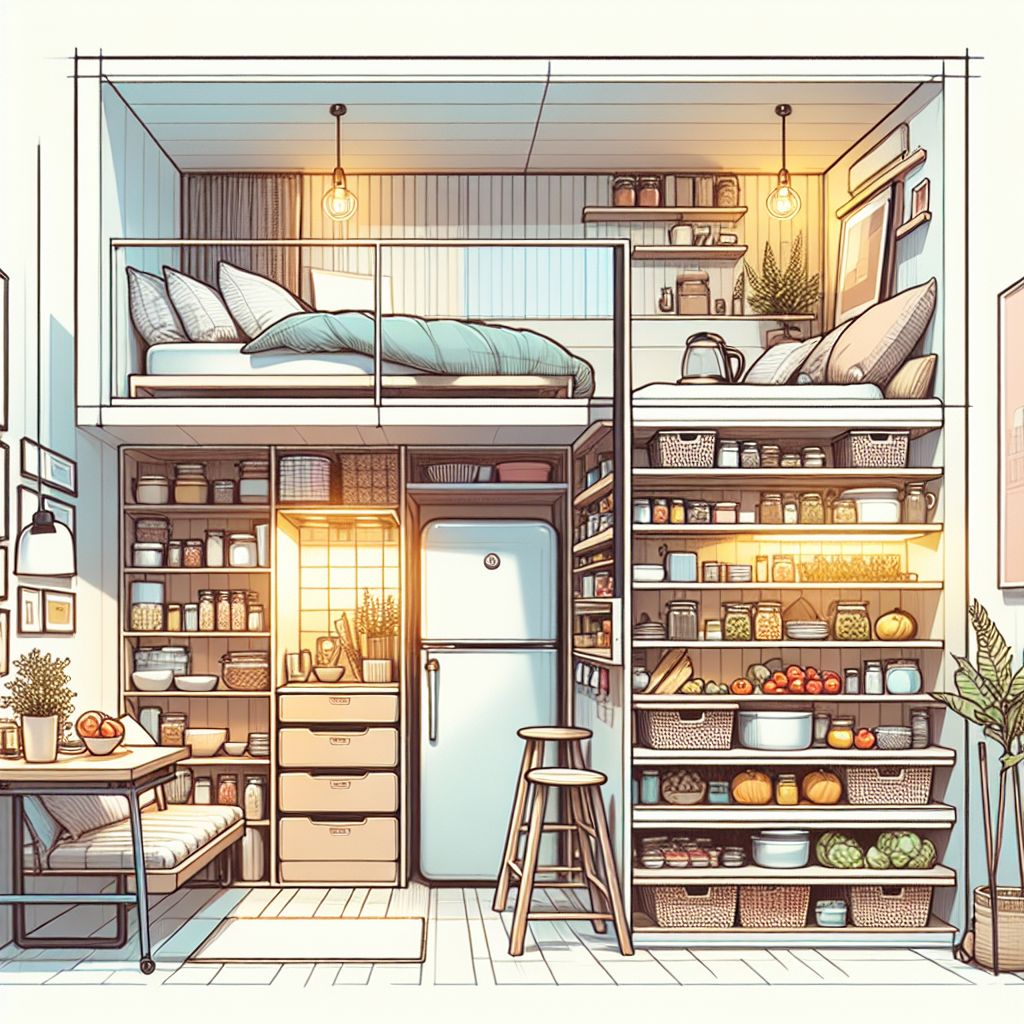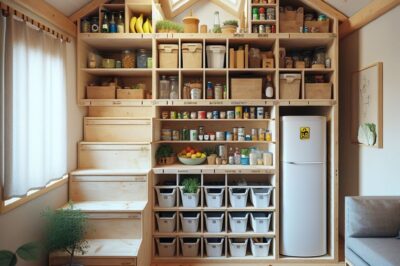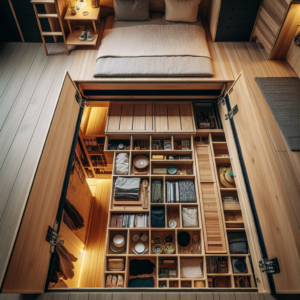Living with less doesn’t just free up space; it frees up your life. In the world of tiny homes, every inch is precious, and a well-organized pantry is not just nice to have—it’s essential. Let’s embark on a journey to transform your tiny home pantry into a minimalist masterpiece, where simplicity and sustainability reign supreme.
Key Takeaways
-
Optimize vertical space with open shelving to keep essentials within reach.
-
Use uniform containers to consolidate pantry items for a streamlined look and improved organization.
-
Incorporate sliding baskets and adjustable shelving to adapt storage to your changing needs.
-
Choose multi-purpose furniture to maximize space in tiny home living areas.
-
Implement a first in, first out system to keep pantry items fresh and reduce waste.
Defining a Minimalist Pantry
A minimalist pantry is more than just a place to store your food; it’s a reflection of a lifestyle choice that prioritizes functionality, simplicity, and beauty. It’s about keeping what you need and love, and nothing more. This means bidding farewell to clutter and hello to a space that supports your daily life seamlessly.

Imagine opening your pantry to see a curated selection of goods, each with a purpose, each with its place. That’s the essence of a minimalist pantry.
Principles of Minimalism in Pantry Organization
When it comes to organizing a minimalist pantry, think clear, clean lines, and accessibility. Every item should be easy to see and reach, reducing the time you spend searching for ingredients. This approach not only saves time but also reduces stress, creating a more harmonious kitchen environment.
Benefits of a Streamlined Pantry
A streamlined pantry isn’t just visually appealing; it’s also practical. It allows for quicker meal prep, easier inventory tracking, and ultimately, less food waste. Plus, a minimalist pantry encourages healthier eating habits, as you’re more likely to reach for wholesome ingredients that are in plain sight.
Assessing Your Pantry Needs
Before diving into reorganization, take stock of what you have. Sort through your pantry and keep only what you use regularly. Donate or discard duplicates, expired items, or anything that no longer serves you. This initial step paves the way for a more functional pantry layout.
Maximizing Space with Vertical Storage Solutions
Vertical storage is a game-changer in tiny homes. It leverages the height of your space, drawing the eye upward and making the room feel larger. Open shelving is particularly effective, providing easy access to everyday items while contributing to an airy, open feel.
Implementing Floating Shelves
Install floating shelves at varying heights to accommodate different-sized items. Place the most frequently used items at eye level and less-used items higher up. This not only makes the best use of space but also keeps your counters clear of clutter.
Using Wall-Mounted Racks
Wall-mounted racks for spices, utensils, or pots and pans are another way to free up valuable cabinet and drawer space. These racks put your items on display in an organized fashion and keep them within arm’s reach.
Choosing Tall, Narrow Storage Units
If floor space allows, a tall, narrow storage unit can be a perfect addition to a tiny home pantry. Its slim profile takes up minimal space while providing ample storage. Look for units with adjustable shelves to customize the storage to your needs.
Choosing the Right Containers for Consolidation
Now, let’s talk about containers. Choosing the right ones can transform your pantry from a haphazard jumble into a neatly organized haven. The key? Uniformity. Using containers of the same shape and size can create a clean, cohesive look and make better use of space.
Selecting Durable, Sustainable Materials
Opt for containers made from sustainable materials like glass or stainless steel. Not only do they look sleek, but they’re also durable and better for the environment than plastic. Plus, they won’t retain odors or stains, keeping your pantry smelling fresh and clean. For more inspiration on maximizing space with smart materials, check out these clever tiny house kitchen storage ideas.
Container Sizing: How to Decide
When selecting container sizes, consider what you’re storing. Bulk items like flour and rice need larger containers, while spices can go in smaller ones. The trick is to choose containers that are big enough to hold your items without wasting space.
Labeling for Efficiency and Ease
Labeling your containers is a must. It not only helps you find what you need quickly but also helps track expiration dates. You can use a simple label maker or get creative with chalkboard labels for a touch of rustic charm.
Innovative Storage Features
Innovative storage solutions are the secret to a well-organized pantry. They can turn dead space into usable storage and make your life a whole lot easier.
Sliding Baskets and Drawers
Consider installing sliding baskets or drawers in your cabinets. They pull out easily, so you can grab what you need without having to dig through the back of a shelf. This is a smart way to utilize every inch of your cupboard space.
Adjustable Shelving for Changing Needs
Adjustable shelving is another smart feature. It allows you to change the height of your shelves to accommodate different-sized items as your pantry contents change. This flexibility is key in a tiny home where every item must earn its keep.
Door-Mounted Storage Accessories
Don’t forget the back of the pantry door. It’s prime real estate for a door-mounted spice rack or a set of hooks for hanging utensils or measuring cups. These accessories keep items off the shelves and within easy reach.
Multi-purpose Furniture Pieces
Multi-purpose furniture is a cornerstone of tiny home living. These pieces work double duty, providing both a function and storage solutions.
Furniture with Hidden Compartments
Look for furniture with hidden compartments. Ottomans that open up to reveal storage, beds with drawers underneath, or benches with lift-up seats can hide away pantry items, linens, or other household goods.
Utilizing Fold-Down Tables
A fold-down table mounted to a wall can serve as a prep space when you’re cooking and tuck away when not in use. Some designs even have built-in shelves for extra storage.
Transforming Seating into Storage
Chairs and stools that open up to store items are perfect for tiny homes. They take up no more space than regular seating but give you an extra spot to stash pantry goods or kitchen tools. For more innovative space-saving furniture ideas, check out our guide on maximizing tiny home loft space.
Storing Perishables Properly
Storing perishables properly is critical in a tiny home pantry. Without proper storage, food can spoil faster, leading to waste and unnecessary expenses.
Temperature Control in Pantry Design
Consider the temperature in your pantry area. Keep it cool, dry, and away from direct sunlight to help extend the shelf life of your perishables. Sometimes, this might mean getting creative with insulation or finding the coolest spot in your home for storage.
Best Practices for Storing Fresh Produce
Fresh produce can be tricky in a tiny pantry. Use produce bins that allow for air circulation to keep fruits and vegetables fresher longer. Also, store ethylene-producing fruits like apples away from other produce to prevent premature ripening.
Another tip is to store root vegetables in a dark, cool drawer or bin to mimic the conditions of a root cellar. This can greatly extend their shelf life.
Utilizing Airtight Containers for Long-Term Storage
For items like grains, nuts, and seeds, airtight containers are your best friend. They keep pests out and freshness in. Vacuum-sealing is another option for items you want to keep for a longer period, like coffee beans or dried fruit.
Rotating Stock and Maintaining a Minimalist Pantry
A minimalist pantry is not a set-it-and-forget-it kind of place. It requires regular maintenance to stay clutter-free and functional.
First In, First Out: Rotation Systems
Adopt the “First In, First Out” method. When you buy new groceries, move the older items to the front so they get used first. This system helps prevent food from expiring and going to waste.
-
Place new cans and jars behind older ones.
-
Use clear bins to group like items together and see what you have at a glance.
-
Regularly check expiration dates and use up items that are nearing their end.
Regular Pantry Audits: Keeping Track of Inventory
Do regular pantry audits. Every month, take everything out, wipe down shelves, and take inventory. This will help you keep track of what you have and avoid overbuying.
Shopping with Intent: Avoiding Overstocking
Shop with intent. Make a list based on what you already have and what you need. This prevents impulse buys that can lead to overcrowding in your pantry and ultimately, waste.
Making the Most of a Tiny Loft Space
If you’re lucky enough to have a loft in your tiny home, it’s a perfect spot for extra storage. But how do you make the most of this often underutilized space? For inspiration, check out these storage ideas for small spaces to create a functional and organized loft area.
Vertical Integration: Harnessing High Ceilings
Use the vertical space by installing shelves all the way up to the ceiling. This takes advantage of the loft’s height and provides ample storage for items you don’t use daily.
Custom Solutions for Awkward Spaces
Custom solutions can turn awkward nooks and crannies into storage gold. Think custom-built shelves that fit into an odd corner or storage boxes designed to slide under low eaves.
Reflective Strategies to Enhance Spaciousness
Finally, use reflective strategies to enhance the feeling of spaciousness in your loft. Mirrors or glossy, light-colored surfaces can make the area feel larger and more open.
DIY Projects for Personalized Pantry Solutions
Roll up your sleeves, because DIY projects can add a personal touch to your pantry while saving you money. Building your own storage solutions allows you to tailor your space exactly to your needs, ensuring every inch is used efficiently.
Building Your Own Storage Racks
Creating custom storage racks can be a fun weekend project. With some basic tools and materials, you can build racks that fit your space and style perfectly. Whether it’s a spice rack, a can organizer, or a wine holder, the possibilities are endless.
Use reclaimed wood for a rustic touch or painted metal for a modern look. Measure your space carefully, and remember, the goal is to maximize your storage without contributing to a cramped feeling.
Upcycling Containers for a Unique Look
Upcycling isn’t just good for the planet; it’s also an opportunity to inject some creativity into your pantry. Old jars, tins, and even cardboard boxes can be transformed into storage containers with a bit of imagination.
Wrap them in decorative paper, paint them, or add some fabric to create a cohesive look. Not only will you be giving new life to items that might otherwise be thrown away, but you’ll also be creating a pantry that’s uniquely yours.
For example, old wine crates can be stacked to make a rustic, customizable shelving unit that’s perfect for storing everything from dishes to dry goods.
Creating Modular Units for Custom Fit
Modular units are ideal for tiny home pantries because they can be adjusted as your needs change. Build boxes or cubes that can be stacked and rearranged to fit different items and spaces. This flexibility is key in a tiny home where your needs might shift over time.
Minimizing Waste with a Sustainability Mindset
Embracing minimalism in your tiny home pantry isn’t just about decluttering; it’s also about adopting a sustainability mindset. This means being mindful of waste, both in terms of food and packaging.
Shopping in Bulk: Reduce Packaging
One of the easiest ways to reduce waste is to shop in bulk. This cuts down on packaging and often saves you money. Store bulk items in your reusable containers to keep your pantry organized and eco-friendly.
-
Bring your own containers to the bulk store to avoid unnecessary packaging.
-
Purchase only the amount you need to minimize food waste.
-
Choose stores that offer a wide variety of bulk items to maximize your options.
Shopping in bulk is not only better for the environment, but it also helps maintain the minimalist aesthetic of your pantry.
Composting Kitchen Scraps
Composting is another key component of a sustainable pantry. By composting your kitchen scraps, you reduce waste and create nutrient-rich soil for your garden. If you’re living in a tiny home, consider a small, odor-free compost bin that fits under the sink or on a balcony.
Reusable Options for Everyday Use
Invest in reusable options for everyday use. This includes beeswax wraps instead of plastic wrap, cloth napkins instead of paper towels, and silicone lids for containers. Not only do these options reduce waste, but they also add to the clean, clutter-free aesthetic of your minimalist pantry.
FAQ
Now, let’s address some frequently asked questions about maintaining a minimalist pantry in a tiny home.
How do you maintain organization in a minimalist pantry?
Maintaining organization in a minimalist pantry is all about consistency. Stick to a regular cleaning schedule, keep an inventory list, and always put items back in their designated spot. Remember, every item should have a home within your pantry.
What are some minimalist storage options that don’t require drilling or permanent installation?
There are plenty of non-permanent storage options that are perfect for renters or those who prefer not to drill holes. Over-the-door racks, freestanding shelving units, and stackable bins can all be used to create additional storage without the need for permanent fixtures.
Can minimalism be practical for large families?
Absolutely! Minimalism is about efficiency and can be adapted to any size family. It might mean more frequent audits and a larger pantry space, but the principles of keeping only what you need and use remain the same.
How often should I reassess my pantry storage solutions?
Reassess your pantry storage solutions at least twice a year. This helps you to stay on top of what you have, prevent overstocking, and adjust your storage solutions as your lifestyle changes.
What are some common mistakes to avoid when creating a minimalist pantry?
When creating a minimalist pantry, avoid overbuying, neglecting to label containers, and choosing style over function. Remember, the goal is to create a space that is both beautiful and practical.
In conclusion, a minimalist tiny home pantry is about more than just storage—it’s about creating a sustainable, clutter-free space that enhances your quality of life. With the right strategies and a bit of creativity, you can achieve a pantry that is both functional and beautiful, no matter the size of your home.





